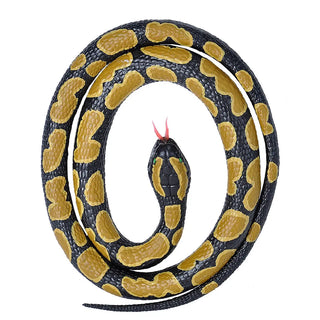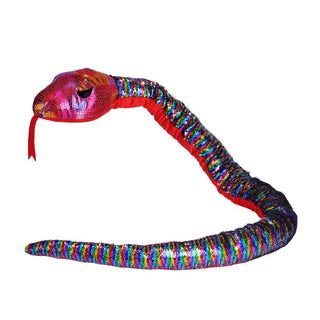Your Search For "rattlesnake" Revealed The Following:
Filter
Active Filters
Blue Rock Rattlesnake Stuffed Animal - 54"
$19.99
- Unit price
- / per
INCLUDES:
- Age:0+
- AnimalType:Blue Rock Rattlesnake
- Blue Rock Rattlesnake
- Brand:Snakesss
- Gender:Boy
- Gender:Girl
- Size:54"
$19.99
- Unit price
- / per
Green Snakes Blue Rock Rattlesnake Stuffed Animal - 36"
$15.99
- Unit price
- / per
INCLUDES:
- Age:0+
- Brand:Green Snakes
- Gender:Boy
- Gender:Girl
- Size:36"
$15.99
- Unit price
- / per
Flip Cars Rattlesnake/Crocodile Action Toy - 3.5"
$8.99
- Unit price
- / per
INCLUDES:
- Age:3+
- Brand:Flip Cars
- Gender:Boy
- Gender:Girl
- Size:3.5"
$8.99
- Unit price
- / per
Green Rock Rattlesnake Stuffed Animal - 54"
$19.99
- Unit price
- / per
INCLUDES:
- Age:0+
- AnimalType:Green Rock Rattlesnake
- Brand:Snakesss
- Gender:Boy
- Gender:Girl
- Green Rock Rattlesnake
- Size:54"
$19.99
- Unit price
- / per
Rattlesnake - Foilkins Snake
$24.99
- Unit price
- / per
INCLUDES:
- Age:3+
- Brand:Foilkins Snake
- Gender:Boy
- Gender:Girl
- Size:54"
$24.99
- Unit price
- / per
Timber Rattlesnake Stuffed Animal - 54"
$19.99
- Unit price
- / per
INCLUDES:
- Age:0+
- AnimalType:Timber Rattlesnake
- Brand:Snakesss
- Gender:Boy
- Gender:Girl
- Size:54"
- Timber Rattlesnake
$19.99
- Unit price
- / per
Luxury Snakes Rattlesnake Stuffed Animal - 54"
$26.99
- Unit price
- / per
INCLUDES:
- Age:0+
- Brand:Luxury Snakes
- Gender:Boy
- Gender:Girl
- Size:54"
$26.99
- Unit price
- / per
Living Earth Snakes Blue Rock Rattlesnake Stuffed Animal - 60"
$16.99
- Unit price
- / per
INCLUDES:
- Age:0+
- Brand:Living Earth Snakes
- Gender:Boy
- Gender:Girl
- Size:60"
$16.99
- Unit price
- / per
Coilkins Sabah Keel Back Stuffed Animal - 12"
$4.99
- Unit price
- / per
INCLUDES:
- Age:0+
- Brand:Coilkins
- Gender:Boy
- Gender:Girl
- Size:12"
$4.99
- Unit price
- / per
Coilkins Eyelash Viper Stuffed Animal - 12"
$4.99
- Unit price
- / per
INCLUDES:
- Age:0+
- Brand:Coilkins
- Gender:Boy
- Gender:Girl
- Size:12"
$4.99
- Unit price
- / per
Rock Python Rubber Snake - 26"
$7.99
- Unit price
- / per
INCLUDES:
- Age:3+
- AnimalType:Python
- Brand:Wild Republic Rubber Snakes
- Gender:Boy
- Gender:Girl
- Python
- Size:26"
$7.99
- Unit price
- / per
Western Diamondback Stuffed Animal - 54"
$19.99
- Unit price
- / per
INCLUDES:
- Age:0+
- AnimalType:Western Diamondback
- Brand:Snakesss
- Gender:Boy
- Gender:Girl
- Size:54"
- Western Diamondback
$19.99
- Unit price
- / per
Cobra Stuffed Animal - 12"
$22.99
- Unit price
- / per
INCLUDES:
- Age:0+
- AnimalType:Cobra
- Brand:Cuddlekins
- Cobra
- Gender:Boy
- Gender:Girl
- Size:12"
$22.99
- Unit price
- / per
Coilkins Blunt Headed Tree Snake Stuffed Animal - 12"
$4.99
- Unit price
- / per
INCLUDES:
- Age:0+
- Brand:Coilkins
- Gender:Boy
- Gender:Girl
- Size:12"
$4.99
- Unit price
- / per
Plush Snake Blunt Headed Snake Stuffed Animal - 54"
$19.99
- Unit price
- / per
INCLUDES:
- Age:0+
- Brand:Plush Snake 54 Inches
- Gender:Boy
- Gender:Girl
- Size:54"
$19.99
- Unit price
- / per
Coilkins Olive Sea Snake Stuffed Animal - 12"
$4.99
- Unit price
- / per
INCLUDES:
- Age:0+
- Brand:Coilkins
- Gender:Boy
- Gender:Girl
- Size:12"
$4.99
- Unit price
- / per
Coilkins Emerald Tree Boa Stuffed Animal - 12"
$4.99
- Unit price
- / per
INCLUDES:
- Age:0+
- Brand:Coilkins
- Gender:Boy
- Gender:Girl
- Size:12"
$4.99
- Unit price
- / per
Ball Python Rubber Snake - 42"
$12.99
- Unit price
- / per
INCLUDES:
- Age:3+
- AnimalType:Python
- Brand:Wild Republic Rubber Snakes
- Gender:Boy
- Gender:Girl
- Python
$12.99
- Unit price
- / per
Printed Jungle Carpet Python Snake Stuffed Animal - 54"
$19.99
- Unit price
- / per
INCLUDES:
- Age:0+
- Brand:Snakesss
- Gender:Boy
- Gender:Girl
- Size:54"
$19.99
- Unit price
- / per
Western Diamondback Snake Stuffed Animal - 110"
$66.99
- Unit price
- / per
INCLUDES:
- Age:0+
- AnimalType:Western Diamondback
- Brand:Snakesss
- Gender:Boy
- Gender:Girl
- Size:110"
- Western Diamondback
$66.99
- Unit price
- / per
Snakesss Eco Blue Rock Rattlesnake Stuffed Animal - 54"
$21.99
- Unit price
- / per
INCLUDES:
- Age:0+
- Brand:Snakesss Eco
- Features:Eco
- Gender:Boy
- Gender:Girl
- Size:54"
$21.99
- Unit price
- / per
Living Earth Snakes Western Diamondback Rattlesnake Stuffed Animal - 60"
$16.99
- Unit price
- / per
INCLUDES:
- Age:0+
- Brand:Living Earth Snakes
- Gender:Boy
- Gender:Girl
- Size:60"
$16.99
- Unit price
- / per
Rainbow Sequin Snake Stuffed Animal - 54"
$24.99
- Unit price
- / per
INCLUDES:
- Age:0+
- AnimalType:Snake
- Brand:Snakesss
- Gender:Boy
- Gender:Girl
- Size:54"
- Snake
$24.99
- Unit price
- / per
Coilkins Borneo Pit Viper Stuffed Animal - 12"
$4.99
- Unit price
- / per
INCLUDES:
- Age:0+
- Brand:Coilkins
- Gender:Boy
- Gender:Girl
- Size:12"
$4.99
- Unit price
- / per
Snakesss Eco Emerald Tree Boa Stuffed Animal - 54"
$21.99
- Unit price
- / per
INCLUDES:
- Age:0+
- Brand:Snakesss Eco
- Features:Eco
- Gender:Boy
- Gender:Girl
- Size:54"
$21.99
- Unit price
- / per
You're viewing 1-25 of 25 results

























